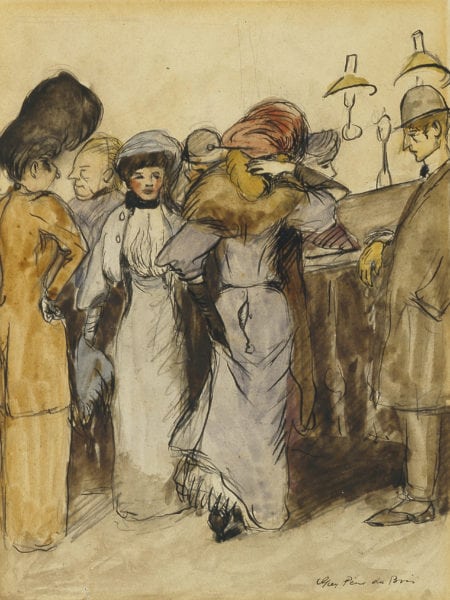The Tenderloin, 1906
Guy Pene du BoisWatercolor and ink on paper
7 3⁄4 × 5 3⁄4 inches
Signed (at lower right): Guy Pène du Bois
Provenance
The artist
Private collection, France
Guy Pène du Bois began his career in art at the age of fifteen when he enrolled at the New York School of Art and studied under three leading American painters: William Merritt Chase, Kenneth Hayes Miller, and Robert Henri. The latter’s approach to painting the world as he saw it was perhaps most influential on the young Pène du Bois, and formed the basis of his aesthetic language. An extended trip to Paris with his father in 1905 further served to inspire the artist, who was enthralled with the fashionable street life and stage performances; he also spent much time exploring the Parisian museums and galleries.
In 1906, Pène du Bois returned to New York and found work at the New York American where he served as a crime reporter by day and an opera critic by night. This window into two varying aspects of society provided him with ample material for his paintings and drawings. Pène du Bois was assigned by his paper’s editors to the Tenderloin District—the area between West 14th and West 34th Streets—where beer gardens, theaters, gambling dens, and bordellos thrived. The artist was quite taken with the lively, sordid activities that took place around him. His works from this period are acutely observed, and he rendered his subjects with a sympathetic, though somewhat humorous, eye.
The Tenderloin Club, where this scene is set, was on West 30th Street, directly opposite the busy police station. Pène du Bois depicts the frenetic activity of the club’s patrons, although his figures appear static. The two women at the center of the composition come and go in what could almost be considered a choreographed movement; they alternate between facing out to the viewer and facing inward, not interacting with each other but each on her way to a destination. Observed from the side is a woman with a longer, mustard-colored jacket and an exaggeratedly large hat. A matron, perhaps, with arms akimbo, she silently observes the younger women. Two men are shown in profile, their gaze directed to the women, both seen and unseen. The muted colors reflect Pène du Bois’ roots as a member of the Ashcan school; the only reds appear in the rouge of the woman coming toward the viewer and the hat of the woman walking away. With a wink to the viewer, the artist has the central woman lift her skirts while she walks, revealing, in the slackened fabric, a missed button and subsequent gaping view of her slip.
Exhibited
- New York: As They Saw it, Bernard Goldberg Fine Arts, The International Fine Art Fair, Park Avenue Armory, New York, May 13 – 18, 2005, p. 4, illus., p. 9.

